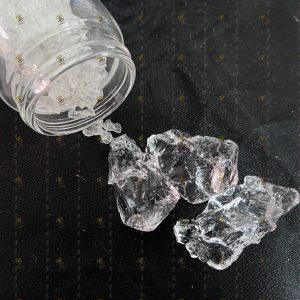Who Invented Poliacrilato di potassio?
Potassium polyacrylate, a powerful superabsorbent polymer, emerged in the early 1970s. It was developed through advances in polymer chemistry by various researchers and organizations, building upon the earlier work done with sodium polyacrylate. The goal was to create materials that could effectively retain water for applications such as soil conditioning and hygiene products.
How Does Potassium Polyacrylate Absorb Water?

Poliacrilato di potassio‘s ability to absorb water lies in its chemical makeup. It consists of long chains of acrylate monomers, each featuring ionized carboxyl groups when combined with potassium ions. These carboxyl groups are highly attractive to water molecules, forming hydrogen bonds and electrostatic interactions. When exposed to water, the polymer chains swell and form a network that captures and retains water. This process is driven by the polymer’s hydrophilic nature and the osmotic pressure created by the dissociated potassium ions.
Why Is Potassium Polyacrylate Highly Absorbent?
The exceptional absorbency of potassium polyacrylate is due to its cross-linked polymer structure. This structure creates numerous spaces within the polymer that can trap water molecules. Potassium ions (K+) enhance this absorption capability by increasing osmotic pressure, causing the polymer to swell significantly. This allows potassium polyacrylate to hold a substantial amount of water relative to its weight, while its cross-linked nature prevents it from dissolving, forming a stable gel.
Why Is Potassium Polyacrylate Used in Diapers?
Potassium polyacrylate, though less common than sodium polyacrylate, is used in diapers for its remarkable water-absorbing properties. It can absorb and retain large quantities of urine, converting it into a gel and keeping the diaper dry. This ensures comfort and reduces the risk of diaper rash and other skin irritations. The polymer’s ability to quickly absorb moisture makes it an excellent component in diaper cores, helping to prevent leaks and maintain dryness.
Can Potassium Polyacrylate Be Recycled?
Recycling potassium polyacrylate is complex due to its intricate chemical structure and post-use contamination. However, several recycling methods are being explored:
- Mechanical Recycling: This method involves physically processing used materials to extract and reuse potassium polyacrylate. Although challenging and costly, it offers a potential way to reduce waste.
- Chemical Recycling: Chemical processes can break down potassium polyacrylate into its monomers or other reusable components. While not yet widely implemented, this approach holds promise for sustainable recycling.
- Biodegradation: Researchers are investigating the use of specific microorganisms or enzymes to degrade potassium polyacrylate. This method, still in experimental stages, could provide an environmentally friendly disposal solution in the future.
In summary, potassium polyacrylate is a versatile and highly absorbent material with significant applications, especially in hygiene products like diapers. Its development has provided effective solutions for moisture management. Although recycling remains a challenge, ongoing research and technological advancements aim to find sustainable methods for managing and reusing this superabsorbent polymer, contributing to environmental sustainability.

